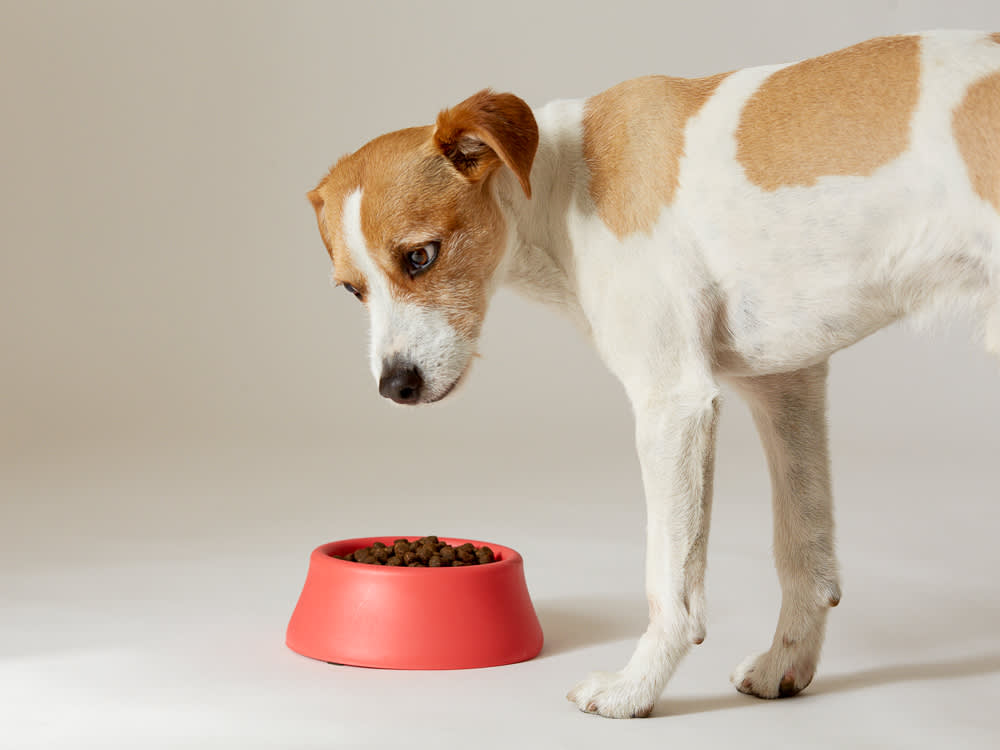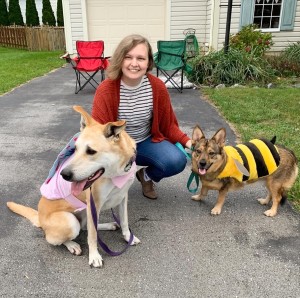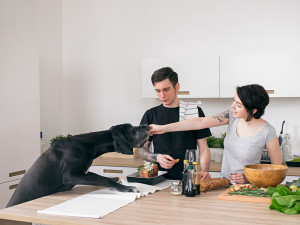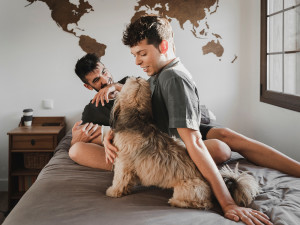How to Get a Dog to Eat
You can’t appease a picky dog with fish fingers like you can with your toddler. Here are some things you can do

share article

Your pet wants you to read our newsletter. (Then give them a treat.)
Parents often have to deal with kids who are picky eaters (sorry if you’re having flashbacks of making pasta 10 times a week). But at least a kid can tell you what foods they don’t like; with a dog, you’re just guessing. When your pup turns their nose up at their dinner bowl, you’re stuck wondering, “Why is my dog not eating?” So, how can you persuade your dog to eat? And how many skipped meals should you allow before you take your pup to the vet for an expert opinion?
A dog without an appetite can definitely be a cause for concern, but there are multiple reasons why your dog may just not be into their food lately. Here, learn about the loss of appetite in dogs and what you can do to persuade your picky pup to chow down.
What causes loss of appetite in dogs?
So, what causes a dog not to eat? Before you start worrying about severe illness, take a look at your home and life. Changes to a dog’s environment or new additions to the family can be just as likely to limit your pet’s appetite as sickness. And while appetite loss is a very common sign of illness, it’s usually accompanied by other symptoms, so don’t fret unless your dog also experiences vomiting, diarrhoea, or another sign of illness.
Temperature and what your dog ate the day before can also be a contributor to why your dog is not eating. Some dogs eat way too much and other dogs are very good at regulating their food intake. If you notice it getting hotter your dog may be lying around more and in turn does not need as many calories that day and chooses to eat less of its meal. If you overfed your dog the day before they may regulate what they are going to take in the following day.
New environment: how to get a newly adopted dog to eat
If you’ve ever felt nervous about starting a new job or moving to a new place, you should be able to sympathise with a dog who’s adapting to a new environment. Whether you just adopted your pup from the animal rescue centre or you’ve moved to a new apartment or home, any change in a dog’s routine or surroundings can cause stress and even put a dampener on their appetite. So, if you notice your newly adopted dog not eating, have a little patience. Usually, a dog will return to their normal eating habits once they’ve grown accustomed to the new situation – generally in just a few days.
Illness: how do you help a sick dog who won’t eat?
If your dog has always maintained a healthy appetite but suddenly won’t even look at their food, it may be a sign of illness. Look for other changes like weight loss and symptoms like vomiting or diarrhoea and contact your vet asap if you notice any. A lack of appetite accompanies a lot of serious illnesses, like pancreatitis, liver and kidney disease, chronic gut issues, and cancer, so it’s best to get your dog checked out as soon as you can.
Picky eater: how to get picky dogs to eat
Some dogs may not refuse all food, just certain ingredients, which usually means that there’s nothing wrong – you just have a picky eater on your hands. Dogs often become picky if they’re frequently fed human food, fed at inconsistent times, or have enjoyed a wide variety of foods and flavours.
Puppies especially tend to be picky eaters but often adjust to their new home and diet over time. If your dog has enjoyed the taste of chicken nuggets or other goodies, they may be a little less than enthused about their dry dog food, so try some healthy snacksopens in a new tab to encourage their appetite.
Anxiety: how to get an anxious dog to eat
While a change in environment can be a source of anxiety, any change in a household can throw a dog’s appetite off. That includes things like a new job that keeps you away from home more often, a new pet or baby in the home, or a death in the family. Any stress can make your dog anxious and cause disruptionsopens in a new tab in both their appetite and normal behaviour. If you’re going through a big life change, try to pay a little extra attention to your dog and work to keep their routine as normal as you can.
New medications or vaccinations
Many medications and vaccinations can have unexpected side effects, such as temporary appetite loss. However, this should pass within a day or two. If your dog is still struggling to show interest in food, try feeding them some plain chicken and rice or schedule a visit with your vet.
Dental problems
If you’ve ever had a toothache, you know the last thing you feel like doing is eating. The same thing can happen to your dog, so check their mouth for anything that may be caught in their teeth or gums. Look out for signs of dental issues like a bad odour, loose teeth, or excess tartar buildup. If you notice a potential problem with your dog’s teeth, it’s time to visit the vet.
Food quality
If your dog stopped eating a food they’ve enjoyed for years, the food itself may be to blame. Try a new package of food to see if your dog likes that better, and if not, there may have been an ingredient change that your pup just doesn’t agree with. Consider trying a new food brand or flavour.
Parental absence
Some dogs just won’t eat when their human parents aren’t around. Remember that dogs are pack animals, and they may feel more comfortable eating with you close by. Try to feed your dog well before you have to go anywhere so you can keep them company while they enjoy their meal.
When should I be concerned about my dog’s lack of appetite?
So, how long can a dog go without eating? If your dog skips a few meals but then begins eating normally again, there’s likely nothing to worry about. However, if your dog hasn’t eaten anything for 24 to 48 hours, reach out to your vet. Make sure to pay closer attention to small dogs because they can become dehydratedopens in a new tab more quickly than larger canines.
Contact your vet immediately if you notice any of the symptoms below in addition to a loss of appetite:
Frequent vomiting or diarrhoea
Lethargy
Sudden weight loss
Excessive thirst
Constipation or unusual stool
What can I do to stimulate my dog’s appetite?
Fortunately, if you have a disinterested or picky dog on your hands, there are plenty of things you can try to encourage your pup to eat:
Try different flavours and brands of dog food. Always make sure to switch between foods gradually so you don’t upset your dog’s stomach.
Mix dry and wet food together.
Add a topper or mix to dry food, such as plain chicken, fish, beef or chicken broth, sweet potatoesopens in a new tab, or pumpkinopens in a new tab.
Warm up your dog’s food. Add a tablespoon of warm water and briefly heat their dinner up in the microwave.
Go for a walk or play before meals to help your dog work up an appetite.
Feed your dog at consistent timesopens in a new tab. Two or three meals a day is best. Don’t leave food out for your dog; keep it out for 15 to 20 minutes before pulling it up.
Use your dog’s dry food as treats. Limit other treats and snacks, or opt for dog-safe human foodsopens in a new tab.
Try using a toy that dispenses food or a puzzle feeder.
Frequently asked questions
How can I tell if my dog is hungry?
Dogs tend to be vocal about their needs, especially when it comes to food! A hungry dog may whine or bark persistently, lick their lips, or even wander throughout the house, looking for a snack. You may also notice frequent and excessive paw licking or digging at the ground.
How can I tell if my dog is eating enough?
One of the best ways to ensure your dog gets plenty of food is to monitor their weightopens in a new tab. Set aside a specific time every two to three days to weigh your pup. Make sure you always use the same scale and weigh them after a walk so they have an empty bladder.
You can also assess your dog’s body condition scoreopens in a new tab and muscle condition scoreopens in a new tab by using the criteria to make sure your pet is in the ideal weight range for their size.
What should I do if my dog throws up after eating?
Sometimes dogs eat too quickly, which can cause them to vomitopens in a new tab immediately after eating. While a single instance of vomiting isn’t a cause for concern, if your dog keeps throwing up after meals, contact your vet. They could have consumed a food or item that is toxicopens in a new tab to them or could be dealing with an illness. If the vet concludes that your dog is only throwing up from eating too fast, consider a slow bowlopens in a new tab.
Resources
Health and welfare information about your dog from Vetlexicon Canisopens in a new tab
Dog Not Eating? Possible Causes and Appetite Solutionsopens in a new tab
WSAVA Global Nutrition Committee - Body Condition Scoreopens in a new tab
WSAVA Global Nutrition Committee - Muscle Condition Scoreopens in a new tab

Savannah Admire
Savannah Admire is a writer, editor, and pet parent to two dogs and a cat. When she’s not writing, you can find her reading, playing Animal Crossing, or being an obnoxious nerd about her favorite movies and TV shows. She lives in Maryland, where she constantly debates whether or not to get a third dog.

Kate Sheofsky
Kate Sheofsky hails from San Francisco, where she developed a love of writing, Giants baseball, and houses she can’t afford. She currently lives in Portland, OR, and works as a freelance writer and content strategist. When not typing away on her laptop, she enjoys tooling around the city with her two rescue pups searching for tasty food and sunny patios.
Related articles
![Dave Coast sitting with a dog]() opens in a new tab
opens in a new tabNutritionist Dave Coast Digs Into Grain-Free Dog Food & Heart Disease
The LA wellness guruopens in a new tab talks to a holistic veterinarian about the best diet for dogs with allergies and why grain-free food gets a bad rap.
![Same sex couple with their dog lying on the bed laughing at his farts]() opens in a new tab
opens in a new tabWhy Do Dogs Fart? Causes and Remedies for Dog Flatulence
Expert solutions for your pup’s unfortunate flatulence.
![shy dog frightened in the arms of the owner. this brown mixed-breed hound puppy has a sweet gaze. the female owner has a wool sweater]() opens in a new tab
opens in a new tabWhy is My Dog Shaking? Causes and Treatment
A vet explains why the weather isn’t always to blame.
![A black dog with a tilted head looks attentively at the camera while sitting in grass.]() opens in a new tab
opens in a new tabIs My Dog’s Poop Normal?
From bloody poop to diarrhea—all your dog’s poop problems explained.
- opens in a new tab
Can Dogs Eat Almonds (and Other Nuts)?
This healthy snack for humans isn't so healthy for your pup. Here's why it's best to avoid them.
![A woman with long dark hair kneeling to feed her Shiba Inu dog from stainless steel dog bowls]() opens in a new tab
opens in a new tabSome Like It Hot — The Benefits of Warming vs. Cooling Diets
Here’s how certain foods can balance your pet’s energy and even ease their allergies, according to Chinese medicine.







